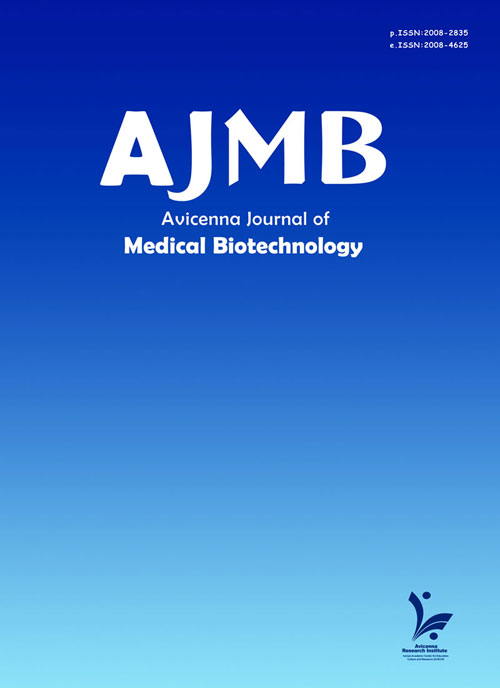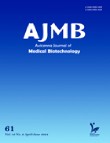فهرست مطالب

Avicenna Journal of Medical Biotechnology
Volume:9 Issue: 4, Oct-Dec 2017
- تاریخ انتشار: 1396/08/02
- تعداد عناوین: 8
-
-
Page 163Needle free vaccines have a several advantages and very attractive way for vaccination. In a body, mucosal surfaces provide a universal entry portal for all the known and emerging infectious pathogenic microbes. Therefore, it seems, vaccination strategies need to be reorganized for vaccines that are hindering the entry capability of pathogenic microbes through mucosal surfaces. Lactic acid Bacteria (LAB) are widely used in the food industry and at the present, used as delivery vehicles for biological investigations. In this review, we summarized the Results of several studies which Lac-tococcus lactis (L. lactis) used as a live vector for vaccines. These bacteria are considered as promising candidates for heterologous expression of proteins and biotechnological usage. LAB are considered as promising candidates for heterologous expression of proteins and biotechnological usage. The results showed that these bacteria have an ability to deliver antigen to immune system. Therefore, developing mucosal live vaccines using lactic acid bacterium, L. lactis, as an antigen delivery vector, is an attractive alternative choice and a safer vaccination strategy against pathogens.Keywords: DNA, Lactococcus lactis, Vaccines
-
Page 169BackgroundPseudomonas putida (P. putida) ATCC12633 can produce creatinase. It is a microbial enzyme which degrades creatinine in bacteria and provides source of carbon and nitrogen. Also, this enzyme is used in the enzymatic measurement of creatinine concentration for diagnosis of renal and muscles functions and diseases. Our purpose was recombinant production of creatinase for using in clinical measurement of serum or urine creatinine.MethodsA 1209bp of open reading frame of creatinase was amplified by PCR from P. putida ATCC12633 genome and cloned into pET28a expression vector which was digested using NheI and XhoI restriction enzymes. Cloning was confirmed by colony PCR, double digestion analysis and sequencing. Recombinant pET28a vector was transformed to Escherichia coli (E. coli) BL21 (DE3). Creatinase expression was induced in E.coli BL21 (DE3) using IPTG and confirmed by SDS-PAGE and western blotting. Purification of creatinase was performed using Ni-NTA column. The specific activity of this enzyme was also investigated.ResultsThe creatinase gene cloning was confirmed by DNA sequencing. Successful expression of creatinase was performed in E. coli (57.4% of total protein). SDS-PAGE and western blot analysis showed a 45 kDa creatinase protein. Purification of creati-nase was done with high purity. The specific activity of recombinant enzyme is 26.54 unit/mg that is much higher than other creatinase used in the commercial kits (9 unit/mg).ConclusionThe P. putida ATCC12633 recombinant creatinase was expressed effi-ciently in E. coli BL21 and 57% of total protein was the recombinant creatinase. Also, expressed creatinase has high solubility and also the enzyme has good activity com-pared to enzymes used in commercial kits, so a new source of creatinase was produced for creatinine assay kit in this study.Keywords: Creatine, Creatinase, Pseudomonas putida
-
Page 176BackgroundStem cell-based therapy is a novel strategy for the treatment of neuro-degenerative diseases. The transplantation of fully differentiated cells instead of stem cells in order to decrease serious adverse complications of stem cell therapy is a new idea.
In this study, the effect of lithium chloride on dopaminergic differentiation of human immortalized RenVm cells was investigated in order to access a population of fully differentiated cells for transplantation in Parkinson disease.MethodsThe immortalized RenVm cells were induced to dopaminergic differentiation using a neurobasal medium supplemented with N2 and different concentrations (1, 3, 6 mM) of Lithium Chloride (LiCl) for 4, 8 and 12 days. The efficiency of dopaminergic differentiation was evaluated using immunocytochemistry and western blot techniques for tyrosine hydroxylase and β-catenin marker expression.ResultsOur results indicated that LiCl can promote dopaminergic differentiation of RenVm cells in a dose-dependent manner.ConclusionIt can be concluded that LiCl is able to facilitate dopaminergic differenti-ation of cultured cells by affecting Wnt-frizzled signaling pathway.Keywords: Beta catenin, Cell differentiation, Lithium, Wnt proteins -
Page 181BackgroundAdvances of nanotechnology have led to the development of nano-materials with both potential diagnostic and therapeutic applications. Among them, Super Paramagnetic Iron Oxide Nanoparticles (SPIONs) have received particular at-tention. Modified EDC coupling fraction was used to fabricate the SPION-C595 as an MR imaging contrast agent for breast cancer detection in early stages.MethodsNanoprobe characterization was confirmed using Fourier Transform Infrared Spectroscopy (FT-IR), Scanning Electron Microscopy with Energy Dispersive X-Ray Spectroscopy (SEM-EDAX), and Photon Correlation Spectroscopy (PCS). Protein and iron concentration of nanoprobe was examined by standard method. MTT assay was performed to evaluate the cytotoxicity of the nanoprobe in breast cancer cell line (MCF-7). T2-weighted MR imaging was performed to evaluate the signal enhancement on T2 relaxation time of nanoprobe using spin-echo pulse sequence.ResultsAs results showed, SPIONs-C595 provided active targeting of breast cancer cell (MCF-7) at a final concentration of 600 µgFe/ml. The final concentration of protein was calculated to be at 0.78 µgprotein/ml. The hydrodynamic size of the nano-probe was 87.4±0.7 nm. The MR imaging results showed a good reduction of T2 relaxation rates for the highest dose of SPIONs-C595.DiscussionBased on the results, SPIONs-C595 nanoprobe has a potential in T2-weighted MR imaging contrast agent for breast cancer cell (MCF-7) detection.Keywords: Breast cancer, Contrast media, Magnetic resonance imaging, Nanoparticles
-
Page 189BackgroundDiagnosis of Non-small Cell Lung Cancer (NSCLC) at an early stage is a daunting challenge due to the deficiency of specific noninvasive markers. MicroRNAs (miRNAs) play important roles in the initiation and progression of NSCLC. Measuring miRNA expression levels could provide a potential approach for the diagnosis of NSCLC. Our goals were to examine miR-223, miR-212, miR-192, miR-3074, SNORD33 and SNORD37 expression levels in tissue and sputum of NSCLC patients and cancer free subjects for molecular diagnosis of NSCLC.MethodsRelative expressions of miR-223, miR-212, miR-192, miR-3074, SNORD33 and SNORD37 were examined with quantitative real-time RT-PCR assay in tissue and sputum obtained from 17 NSCLC patients and 17 controls.ResultsmiR-3074 was upregulated in tissue samples of NSCLC patients compared with control group. miR-223 was upregulated, miR-212 and SNORD37 were downer-gulated in sputum samples of patients compared with controls. miR-223 quantification produced 82% sensitivity and 95% specificity with areas under the ROC curve at 0.90 in detection of NSCLC.ConclusionmiR-223 clearly discriminated cancer patients from cancer-free subjects and our results suggest that miR-223 could be a diagnostic useful biomarker. The measurement of altered miRNA expression in sputum samples manifested the potential noninvasive approach for detection of lung cancer.Keywords: MicroRNAs, Non-small cell lung carcinoma, Sputum
-
Page 196Backgroundβ-thalassemia is the most common monogenic disorder in Iran, and one of the challenges in the screening of the carriers is the coinheritance of α-thalassemia mutations. In the view of high prevalence of α-thalassemia mutations in many parts of the country, the aim of this study was to determine the carrier frequency of common alpha deletions, as a secondary modifier in clinical manifestations of beta thalassemia, in known beta-thalassemia carriers and some hematology parameter changes.MethodsThe study included families referred from different primary health care centers with microcytic hypochromic anemia [MCV3.4%]. Genomic DNA was extracted from peripheral blood leukocytes by salting out method. For common β-globin gene mutation analysis, amplification refractory mutation system- polymerase chain reaction (ARMS-PCR) and for rare β-thal alleles, DNA sequencing were used. Also, for investigation of common α-globin gene cluster deletions (-α3.7, -α4.2, --MED and -α20.5), multiplex Gap-PCR was performed.ResultsAmong 227 β-thalassemia minor individuals studied, α-globin gene deletions were found in 43 cases: 37 heterozygote -α3.7 (16.3%), 5 homo -α3.7 (2.2%) and 1 --MED (0.44%). Also, the co-inheritance of α-globin gene deletion and triplication was not found in the studied individuals.ConclusionAlthough it is highly recommended that physicians and genetic counselors involved in the screening program of beta-thal major in the country consider this phenomenon because of high prevalence of this coinheritance, hematologic indices changes are very slight.Keywords: Alpha thalassemia, Beta thalassemia, Hypochromic anemia
-
Page 201BackgroundThe human OCT4 gene, responsible for pluripotency and self-renewal of Embryonic Stem (ES) and Embryonic Carcinoma (EC) cells, can generate several tran-scripts (OCT4A, OCT4B-variant 2, OCT4B-variant 3, OCT4B-variant 5, OCT4B1, OCT4 B2 and OCT4B3) by alternative splicing and alternative promoters. OCT4A that is responsible for ES and EC cell stemness properties is transcribed from a promoter upstream of Exon1a in those cells. The OCT4B group variants (OCT4B-variant2, OCT4B-variant3, OCT4B-variant5, OCT4B1, OCT4B2 and OCT4B3) are transcribed from a different promoter located in intron 1 and some of them respond to the cell stresses, but cannot sustain the ES/EC cell self-renewal. However, the exact function of OCT4B group variants is still unclear.MethodsIn the present study, we employed RT-PCR and sequencing approaches to explore different forms of OCT4 transcripts.ResultsOur data revealed that the OCT4B group variants (OCT4B-variant2, OCT4 B-variant3, OCT4B1, OCT4B2 and OCT4B3) have longer 5' UTR in the human bladder carcinoma cell line of 5637.ConclusionThese OCT4 variants undergo alternative splicing in their 5' UTR which might exert regulatory roles in transcription and translation mechanisms.Keywords: Alternative splicing, Genes, 5'untranslated regions
-
Page 205BackgroundOsteopetrosis is a group of genetically heterogonous diseases and the main feature of that is increased bone density due to osteoclasts abnormality. It has three clinical forms based on inheritance pattern, severity and age of onset: the dominant benign form (ADO), the intermediate form (IRO) and the recessive severe form (ARO). One of the recently discovered genes for ARO form is SNX10 that accounts for 4% of affected persons by this type.MethodsIn this paper, a 15 years old girl affected by osteopetrosis has been analyzed for detecting causal mutation in known osteopetrosis genes. To get it done, amplified exons of the genes were sequenced and then were analyzed.ResultsDirect sequencing of SNX10 gene showed a homozygous c.43delG variant in the patient. Both healthy parents were heterozygous for this variant. In silico analysis revealed that this novel variant can be considered as the cause of disease in the patient.ConclusionIn this paper, a girl affected by osteopetrosis with a novel deletion in SNX10 gene was reported.Keywords: Iran, Mutation, Osteopetrosis, SNX10


